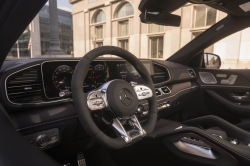
— A Mercedes-Benz HVAC settlement includes current and former owners and lessees of these vehicles.
- 2008-2019 Mercedes-Benz C-Class
- 2010-2015 Mercedes-Benz GLK-Class
- 2012-2017 Mercedes-Benz CLS-Class
- 2010-2019 Mercedes-Benz E-Class
- 2015-2019 Mercedes-Benz GLA-Class
- 2013-2016 Mercedes-Benz GL-Class
- 2016-2019 Mercedes-Benz GLE-Class
- 2017-2019 Mercedes-Benz GLS-Class
- 2012-2015 Mercedes-Benz M-Class
- 2016-2019 Mercedes-Benz GLC-Class
According to the Mercedes heating and cooling system class action lawsuit, the vehicles are defectively designed which allows mold and mildew odors into the vehicle cabins.
Mercedes denies the claims and accusations in the lawsuit, and the automaker says it denies all allegations of wrongdoing. However, Mercedes says it settled the lawsuit due to the time and expense of a trial.
The Mercedes-Benz HVAC settlement may provide eligible customers reimbursements for costs paid for certain past repairs of the HVAC system, and coverage for those repairs in the future.
The percentage of reimbursement or coverage is on a sliding scale based on the age of the vehicle.
- Warranty coverage period (the earlier of 4 years from in-service date or 50,000 miles, under standard warranty) — 100%
- From end of warranty coverage period to the earlier of 8 years from in-service date or 100,000 miles — 70%
- From end of prior period to the earlier of 10 years from in-service date or 125,000 miles — 50%
Past and Future Repairs Under the Mercedes HVAC Settlement
An affected vehicle owner or lessee must submit a claim form to request reimbursement for past repairs that occurred before December 7, 2020. The repair must have related to a customer complaint about mold or mildew odors from the HVAC system.
Past repairs include cleaning the evaporator and replacing the filter. Evaporator replacement is included as a past repair only if the replacement was done at an authorized dealership.
A future repair is any repair to clean the evaporator or replace the filter that is performed at a dealership on or after December 7, 2020. The settlement says you do not need to bring your vehicle in for a future repair until and unless you experience moldy, mildewy odors from the HVAC system. Only current owners and lessees are eligible for future repairs.
Along with your claim form, you must submit the following proof:
- Documentation showing the vehicle received a past repair, the reason for the repair and the cost of the repair. A repair will not qualify for reimbursement if the invoice or other documentation either omits the reason for the repair or describes an odor source other than moldy or mildew odors originating from the HVAC system.
- Reasonable documentation that you paid for the repair such as a credit card statement, an invoice showing a zero balance, a receipt showing payment or other proof.
- Proof that you owned or leased the vehicle at the time of the repair such as a copy of the vehicle title, vehicle registration, lease agreement, insurance documentation or financing documentation.
There are additional requirements if repairs were performed by an independent repair shop.
You must provide proof that within a six-month period prior to the first past repair, the vehicle was diagnosed by a Mercedes dealer as having mold or mildew odors originating from the HVAC system.
The maximum reimbursement for a single past repair performed by an independent facility will not exceed $300. And the total reimbursement shall not exceed $900 if there were multiple past repairs.
However, no reimbursement will be paid for replacement of the evaporator if it was replaced by an independent repair shop.
For repairs that occurred between May 11, 2020, and December 7, 2020, a claim form must be submitted within 75 days of the date of the repair.
Coverage for Future Repairs
According to the Mercedes-Benz HVAC settlement, if and when a mold or mildew HVAC odors appear, bring your vehicle to a dealership to receive a future repair. All covered vehicles are eligible for unlimited future repairs until 10 years after their in-service date or 125,000 miles, whichever comes first.
A Mercedes technician will perform an odor diagnostic test and verify the source of the odor in the vehicle is mold or mildew odors originating from the HVAC system. To qualify for coverage, you must present the following items of proof to the dealer at the time coverage is requested.
Proof the vehicle’s currently installed filter is a Mercedes-Benz brand or other approved filter.
Such proof includes, but is not limited to, a dealer technician examining the filter and determining whether it is an approved filter, a service center invoice indicating installation of an approved filter in the vehicle or a receipt of purchase of an approved filter that was self-installed.
Proof the vehicle received proper timely service in compliance with the vehicle’s maintenance schedule for the two service intervals immediately prior to the requested repair.
Such proof includes documentation from a dealership or repair shop indicating the vehicle’s maintenance history, information found in dealer service records or receipts for parts and materials used for maintenance that you performed on the vehicle.
The attorneys who represented Mercedes owners will receive $5.4 million.
To learn more about the Mercedes-Benz HVAC settlement, please visit www.MercedesHVACSettlement.com.
The Mercedes-Benz HVAC odor lawsuit was filed in the U.S. District Court for the Northern District of Georgia, Atlanta Division - Amin, et al., v. Mercedes-Benz USA, LLC and Daimler AG.
The plaintiffs are represented by Lieff Cabraser Heimann & Bernstein, LLP, and Corpus Law Patel, LLC.




